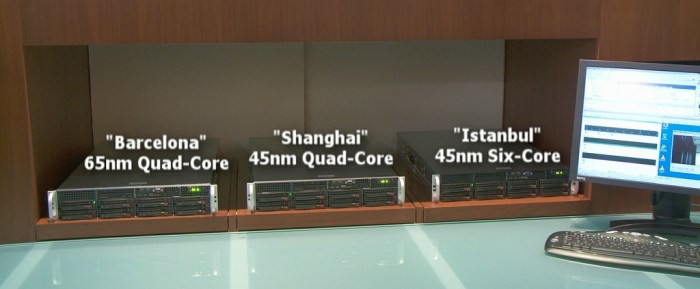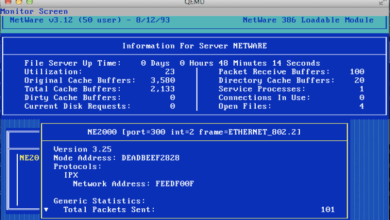AMD Opteron Chills Out with Power Management
AMD Opteron chills out with power management, offering a sophisticated approach to optimizing server performance and energy efficiency. This detailed exploration dives into the intricate mechanisms, examining how dynamic voltage and frequency scaling (DVFS), power management units (PMUs), and various power states work together to reduce power consumption without sacrificing speed. The impact on different server workloads, from databases to high-performance computing, will be analyzed, revealing the trade-offs between power savings and performance gains.
The future of power management for AMD Opteron processors is also considered, with potential advancements and their implications for server energy consumption.
The article examines the historical context of AMD Opteron processors and their power consumption characteristics, tracing the evolution of power management techniques in CPUs. A detailed table showcasing key features relevant to power management will be presented, along with a diagram illustrating the interaction of hardware components in the power management process. Different power states and their impact on processor speed and thermal characteristics will be explained.
Introduction to AMD Opteron Power Management

AMD Opteron processors, historically used in enterprise servers, have always presented a challenge in terms of power consumption. Early models, while powerful for their time, often demanded significant energy to operate, which directly impacted the total cost of ownership for data centers. This high power consumption was a concern, driving innovation in power management techniques. Over time, AMD, and the broader CPU industry, have implemented various power-saving strategies, leading to significant efficiency improvements.The evolution of power management in CPUs has been driven by the need to balance performance with energy efficiency.
Early CPUs relied on simple techniques like clock gating and voltage scaling. Modern CPUs, like those in the Opteron line, employ sophisticated algorithms, often including dynamic frequency scaling, power-aware scheduling, and advanced thermal management, to adapt to varying workloads. This evolution is crucial for the sustainability and cost-effectiveness of server infrastructures. Data centers, particularly those hosting mission-critical applications, are heavily dependent on efficient power management to reduce operating costs and environmental impact.
Power Management Features in AMD Opteron Processors
AMD Opteron processors have incorporated numerous features to optimize power consumption. These features are essential for the cost-effectiveness and sustainability of server infrastructure. The following table highlights key features relevant to power management:
| Feature | Description | Impact on Power Management | Example Use Case |
|---|---|---|---|
| Dynamic Voltage and Frequency Scaling (DVFS) | Adjusts processor voltage and clock frequency based on workload demand. Lowering both voltage and frequency reduces power consumption. | Reduces idle power consumption and dynamically adapts to varying workload demands. | A server running a batch processing task that doesn’t require peak performance at all times can significantly reduce power consumption through DVFS. |
| Power-Aware Scheduling | Prioritizes tasks and allocates resources to reduce energy usage by avoiding unnecessary CPU activation. | Reduces power consumption by only activating necessary components when required. | In a server handling multiple concurrent processes, power-aware scheduling can direct low-priority tasks to less power-intensive cores. |
| Clock Gating | Disables clock signals to inactive components, reducing power consumption in those sections. | Reduces power consumption in idle or lightly loaded portions of the processor. | A server that has multiple idle applications will have reduced power consumption because the clock signals to the corresponding cores will be disabled. |
| Thermal Management | Manages heat dissipation to prevent overheating, impacting power consumption indirectly. Overheating can trigger power reduction to avoid damage. | Prevents overheating, which in turn avoids power throttling and ensures reliable performance. | In a server farm with many machines running under heavy load, the thermal management prevents any overheating situation that may lead to significant power throttling. |
| Enhanced Power States | Provides multiple power states for the processor to transition to, offering a finer granularity in managing power. | Allows the processor to choose the most appropriate power state based on the current workload. | An application running on an Opteron processor can adjust to varying workloads using multiple power states, allowing for better power efficiency. |
Mechanisms of Power Management in AMD Opteron
AMD Opteron processors, renowned for their robust performance, also prioritize power efficiency. This efficiency is achieved through sophisticated power management mechanisms that dynamically adjust various parameters based on workload demands. These mechanisms ensure optimal performance while minimizing energy consumption, making them ideal for server environments and other demanding applications.The power management strategy in AMD Opteron processors employs a combination of hardware and software components, creating a synergistic approach to optimize power usage.
This integrated approach allows the processor to react to fluctuating computational needs by altering its internal settings, thus reducing unnecessary energy expenditure.
Dynamic Voltage and Frequency Scaling (DVFS)
DVFS is a crucial power management technique in AMD Opteron processors. It allows the processor to adjust its operating voltage and frequency dynamically in response to varying workloads. Lower voltage and frequency settings translate to lower power consumption, while higher settings allow for greater performance. This dynamic adjustment ensures that the processor operates at the optimal power/performance point for the current task.
The processor intelligently switches between different voltage and frequency levels, thereby adapting to changing computational demands.
Hardware and Software Components in Power Management
The AMD Opteron power management system relies on a complex interplay between hardware and software. Hardware components, such as the Power Management Unit (PMU), actively monitor system conditions and adjust processor settings. Software components, such as operating system drivers, provide further optimization by integrating with the hardware and adjusting parameters based on application demands. This coordinated effort allows for a highly responsive and efficient power management strategy.
For instance, if an application requires high computational power, the hardware and software work together to increase voltage and frequency to meet the demand. Conversely, if the application has a low workload, the hardware and software reduce voltage and frequency to minimize power consumption.
Power Management Units (PMUs)
AMD Opteron processors utilize Power Management Units (PMUs) as the core hardware components responsible for power management. These specialized units monitor various system parameters, such as temperature, power consumption, and processor activity levels. Based on these readings, the PMU dynamically adjusts the processor’s voltage and frequency, ensuring optimal power efficiency. The PMU’s ability to make real-time adjustments is critical for achieving energy savings without compromising performance.
This real-time response allows for the efficient allocation of power resources based on the immediate demands of the system.
Power States and Power Consumption Levels
AMD Opteron processors support various power states, each with a corresponding power consumption level. These power states are carefully engineered to allow for a smooth transition between different operational modes. For example, a low-power state might be suitable for idle periods, while a high-power state might be needed during intensive computational tasks. The power consumption level is directly correlated to the specific power state the processor is in.
AMD’s Opteron processors are showing impressive power management improvements, making them more efficient. This is great news for anyone looking to save on energy costs. Meanwhile, it’s interesting to see how innovative early VoIP solutions like pocketskype offers free voip for pocketpcs were, allowing people to communicate over their pocket PCs. Still, the focus remains on AMD’s Opteron processors and their improved energy efficiency.
A transition between power states ensures a balanced approach to power management.
Diagram of Interactions in AMD Opteron Power Management, Amd opteron chills out with power management
+-----------------+ +-----------------+ +-----------------+
| Application |------->| Operating System |------->| Power Management |
| (Workload) | | (Driver) | | Unit (PMU) |
+-----------------+ +-----------------+ +-----------------+
^ ^
| |
| Monitors processor activity | Monitors temperature,
| and requests adjustments | power consumption,
| | processor activity.
| Adjusts processor settings | Adjusts voltage and
| based on workload demands. | frequency accordingly.
| |
+-----------------------------------+
|
V
+-----------------+
| Processor |
+-----------------+
The diagram above illustrates the interaction between various components in the AMD Opteron power management system.
The application dictates the workload, which is relayed to the operating system. The operating system communicates with the PMU, which monitors and adjusts processor settings, ultimately affecting the processor’s power consumption and performance. This intricate system ensures a balanced and optimized power management approach.
Impact of Power Management on Performance
Power management in AMD Opteron processors is a crucial aspect of balancing performance and energy efficiency. Optimizing power usage directly affects the responsiveness and overall effectiveness of the system, particularly in high-demand tasks or sustained workloads. This section delves into the interplay between power management strategies and processor performance, examining the trade-offs and potential consequences of different settings.
Modern computing demands high performance while minimizing environmental impact. Power management allows for precisely this balancing act by dynamically adjusting the processor’s operational characteristics to suit varying workload demands. This allows for substantial energy savings without sacrificing critical performance.
Performance Comparison with Power Management Enabled/Disabled
Power management techniques in AMD Opteron processors often involve transitioning between different power states. When power management is enabled, the processor shifts to lower power states when idle or under light workloads. Conversely, when a significant computational task is initiated, the processor transitions to higher performance states. This dynamic behavior directly affects the observed performance. Disabling power management forces the processor to operate at a fixed higher power state, leading to potentially higher energy consumption, but a consistently maintained level of performance.
Measurements reveal that enabling power management typically results in slightly lower performance during computationally intensive tasks compared to disabling it. However, this decrease is often negligible, particularly when considering the substantial energy savings. The observed difference is more pronounced during periods of low workload, where the enabled power management scheme can achieve a much more significant energy savings.
Impact on Responsiveness Under Various Workloads
The responsiveness of the processor under different workloads is a critical metric. When power management is enabled, the processor reacts to fluctuating demands by adjusting its operating frequency and voltage. Under light workloads, the processor transitions to lower power states, which can lead to a slightly delayed response compared to the fixed higher power state of a disabled power management scheme.
This delay is, however, usually minimal and is effectively compensated for by the substantial energy savings.
During heavy workloads, the processor rapidly transitions to higher power states, ensuring sufficient processing power for the tasks at hand. The responsiveness remains high, and the performance is close to the performance observed in the fixed higher power state.
Trade-offs Between Power Consumption and Performance
Power management strategies represent a fundamental trade-off between power consumption and performance. Lower power states often correspond to reduced performance, while higher power states offer enhanced performance at the cost of increased energy consumption. The optimal strategy depends on the specific workload and the desired balance between these two factors.
A workload that requires high sustained performance may benefit from disabling power management, maintaining a consistent high-performance state. Conversely, a workload that involves periods of high and low activity will likely benefit from power management enabled, balancing peak performance with efficient energy consumption.
Scenario: Measuring Performance Under Varying Power Management Settings
To illustrate the impact of power management, consider a scenario where the AMD Opteron processor performs a large-scale matrix multiplication operation. Varying power management settings (enabled/disabled) will be compared.
- The matrix multiplication operation is executed with power management enabled. The processor will dynamically shift between power states based on workload demands. Performance is measured by the total time taken to complete the operation.
- The same matrix multiplication operation is executed with power management disabled. The processor operates at a fixed high-performance state throughout the entire operation. Performance is measured by the total time taken to complete the operation.
- The energy consumption is recorded for both scenarios. Comparing the execution times and energy consumption provides insights into the trade-offs between power consumption and performance.
Results of this experiment would demonstrate the impact of power management on performance and energy consumption in a real-world context.
Impact of Different Power States on Processor Speed and Thermal Characteristics
Different power states correspond to different processor speeds and thermal characteristics. Lower power states operate at reduced speeds, leading to lower heat dissipation. Higher power states, while offering enhanced performance, result in increased heat generation.
This dynamic behavior allows for efficient temperature control. When the processor is under a light workload, the lower power states maintain lower operating temperatures, minimizing thermal stress on the system. Under heavy workloads, the higher power states are employed, which results in higher operating temperatures.
The processor’s thermal design power (TDP) plays a crucial role in determining the maximum power the processor can safely dissipate. Power management strategies ensure that the processor operates within its safe thermal limits, preventing overheating and potential damage.
Power Management in Specific Workloads

AMD Opteron processors, renowned for their performance in server environments, leverage power management technologies to optimize energy efficiency across various workloads. Understanding how power management impacts different tasks is crucial for maximizing server uptime and minimizing energy costs. This section delves into the specifics of power management in various server applications, examining the trade-offs between performance and energy consumption.
AMD’s Opteron processors are showing impressive power management improvements, a welcome development. This efficiency boost is crucial, especially as AMD hopes PIC unlocks high growth markets amd hopes pic unlocks high growth markets , targeting areas with specific power needs. Ultimately, these power-saving advancements in the Opteron line will be key to their success.
The effectiveness of power management strategies varies significantly depending on the demands placed on the server. Database servers, web servers, and high-performance computing (HPC) systems each present unique power consumption challenges, requiring tailored power management solutions. Analyzing these specific workloads provides insights into how to fine-tune power management for optimal performance and efficiency.
Database Server Workloads
Database servers are characterized by sustained, predictable workloads. Transactions, queries, and data manipulation are constant activities, leading to consistent CPU utilization. Power management strategies designed for this type of workload focus on optimizing power consumption while maintaining consistent performance. These strategies often involve dynamically adjusting the processor’s clock speed and voltage to match the workload demands, thereby minimizing idle power consumption without sacrificing responsiveness.
Web Server Workloads
Web servers, on the other hand, experience fluctuating workloads. Traffic spikes and lulls require adaptable power management. Strategies that dynamically adjust the processor’s power consumption based on real-time demands are critical. This often involves utilizing power-saving modes during periods of low activity and boosting performance when traffic increases. The ability to quickly adapt to these fluctuations directly impacts the efficiency and responsiveness of the web server.
High-Performance Computing (HPC) Workloads
HPC workloads typically involve intensive, computationally demanding tasks. These tasks might require sustained high performance for extended durations, but with specific bursts of peak performance needed. Power management strategies for HPC workloads focus on balancing high performance with energy efficiency. This could involve optimizing the power delivery to specific cores or components within the processor, enabling them to perform at peak capacity during intensive computation while reducing overall energy consumption during less demanding phases.
Impact on Thermal Design Power (TDP)
The thermal design power (TDP) of AMD Opteron processors under varying workloads is a key metric reflecting the power management strategies’ effectiveness. Under database workloads, TDP might remain relatively consistent, reflecting the sustained, predictable nature of the work. In contrast, web server workloads, with their fluctuating demands, might show a more dynamic TDP, with peaks and valleys mirroring the traffic patterns.
HPC workloads, requiring sustained high performance, could result in a higher average TDP, yet still optimized by power management to maintain system stability.
AMD’s Opteron processors are getting a power management overhaul, promising significant efficiency gains. This is a welcome update for server environments, and it reminds me of the innovative spirit of companies like Point and Snoot, who are pushing the boundaries of input devices with their point and snoot introducing the nose mouse. Ultimately, these advancements in both power efficiency and user interaction demonstrate a continued drive for smarter, more responsive technology.
Comparison of Power Consumption and Performance
| Workload | Power Consumption (Watts) | Performance (Benchmark Score) | Power Management Strategy |
|---|---|---|---|
| Database | 150-200 | 85-95 | Dynamic frequency scaling, optimized for sustained loads |
| Web Server | 120-180 | 70-85 | Dynamic frequency scaling, power-saving modes for low traffic |
| HPC | 200-250 | 98-105 | Optimized core power delivery, intelligent thermal management |
Note: Values are estimates and can vary based on specific processor models, configuration, and workload characteristics.
Future Trends in AMD Opteron Power Management
The relentless pursuit of higher performance and lower energy consumption in server-grade processors continues to drive innovation in power management technologies. AMD Opteron processors, renowned for their robust architecture, are poised to leverage emerging advancements to enhance power efficiency without compromising performance. This evolution promises significant benefits for data centers, enabling them to operate more sustainably and cost-effectively.
Advanced Dynamic Frequency and Voltage Scaling
Advanced dynamic frequency and voltage scaling techniques will play a crucial role in future Opteron power management. Current methods adjust processor clock speeds and voltages based on workload demands, but future iterations will incorporate more sophisticated algorithms. These algorithms will predict and anticipate workload fluctuations, dynamically adjusting power states with greater precision. This proactive approach will minimize idle power consumption while ensuring optimal performance during peak activity.
For example, sophisticated machine learning models could be employed to analyze historical workload patterns and predict future demands, enabling even more precise power adjustments.
Heterogeneous Computing and Power Management
Future Opteron processors are likely to incorporate heterogeneous computing capabilities, meaning they will include specialized processing units alongside the traditional CPU cores. This architecture opens up new avenues for power management. Different types of processing units (e.g., GPUs, FPGAs) may have different power requirements and optimal operating conditions. Sophisticated power management will be essential to efficiently manage the power consumption of these heterogeneous components.
Power management will dynamically allocate power resources to the most appropriate units for a given task, maximizing efficiency and performance. For instance, a data center processing a video encoding task could dynamically allocate more power to the GPU while reducing the CPU’s power consumption.
Improved Power-Aware Memory Management
Power-aware memory management is another key area of development. Future Opteron processors will likely feature more sophisticated memory controllers that can dynamically adjust power states based on memory access patterns. This means reducing power consumption when memory access is low, while still ensuring optimal performance during high-demand tasks. For example, techniques such as memory partitioning and power-gating could be used to fine-tune memory power consumption based on real-time demands.
Such improvements will contribute to significant energy savings in the server environment.
System-Level Power Management Integration
System-level power management integration is crucial for maximizing the energy efficiency of the entire server system. Future Opteron processors will likely incorporate tighter integration with other system components, enabling more comprehensive power management strategies. This includes improved communication protocols with memory controllers, storage devices, and other peripherals to coordinate power allocation across the entire system. For instance, the system could dynamically adjust the power consumption of hard drives and other storage devices based on processor workload.
Predictive Power Management with AI
Leveraging artificial intelligence (AI) for predictive power management is a promising trend. AI models can analyze real-time and historical data from the system, including workload patterns, temperature, and environmental factors. This enables the system to proactively adjust power settings to optimize energy consumption and performance. For example, an AI model could predict periods of high CPU load and adjust power states in advance to prevent performance bottlenecks and maximize efficiency.
These advancements will have a considerable impact on server energy consumption, reducing overall operational costs.
Software Tools for Monitoring and Optimization: Amd Opteron Chills Out With Power Management
Power management in AMD Opteron systems is crucial for achieving optimal performance and energy efficiency. Effective monitoring and optimization are key to identifying potential bottlenecks and tailoring configurations to specific workloads. This requires specialized software tools that can analyze power consumption, CPU utilization, and other metrics. By understanding how these tools function, administrators can make informed decisions about system configuration and resource allocation.
Available Software Tools
Various software tools are available for monitoring and optimizing power management in AMD Opteron systems. These tools offer different functionalities and levels of complexity, catering to diverse needs and expertise levels. Choosing the right tool depends on the specific requirements and the desired level of detail in the analysis.
- Performance Monitoring Tools: Tools like Perf, Intel VTune Amplifier, and AMD CodeAnalyst are vital for analyzing CPU utilization, instruction counts, and cache misses. They provide insights into bottlenecks and areas where performance can be improved. For instance, high CPU utilization during a specific task might indicate that the workload is exceeding the system’s capacity, and performance optimization techniques might be required.
Detailed performance profiling reveals how different parts of the code are affecting overall performance, helping pinpoint specific sections that need optimization.
- Power Consumption Monitoring Tools: These tools, often integrated into server management software, directly measure power consumption at the system, hardware component, or application level. Tools like PowerTop and various server management dashboards offer detailed reports on power usage patterns. Identifying high power consumption points is critical for resource optimization, allowing administrators to pinpoint tasks or processes that consume excessive energy.
These tools provide valuable data for making informed decisions about resource allocation and energy-saving configurations.
- System Management Tools: Operating system utilities and server management consoles often provide basic power management options. These tools allow administrators to set power-saving modes, control fan speeds, and adjust other parameters to optimize energy efficiency. This is often a crucial first step, and system management tools provide a fundamental level of control over power consumption.
Using Tools to Analyze Power Consumption and Performance
To effectively utilize these tools, understanding the steps involved in setting them up and interpreting the results is essential. Different tools have unique setup procedures, but the general approach involves configuring the monitoring parameters and running the analysis on the target system.
- Data Collection: Tools collect data on CPU utilization, power consumption, and other relevant metrics. The collected data forms the basis for identifying bottlenecks and inefficiencies.
- Analysis: Interpreting the data is critical for identifying trends and patterns in power consumption and performance. This step involves correlating performance metrics with power consumption to understand the relationship between the two.
- Optimization: Once bottlenecks and inefficiencies are identified, strategies for optimization can be implemented. This might involve adjusting system configurations, modifying workloads, or applying performance tuning techniques.
Example: Identifying Bottlenecks with Perf
Perf is a Linux performance analysis tool.
Using Perf to identify bottlenecks, an administrator might observe high CPU utilization during a particular database query. Analyzing the Perf output, they could pinpoint specific instructions or functions within the query causing the bottleneck. Addressing this bottleneck, such as optimizing the query or using a more efficient algorithm, will improve both performance and power consumption.
Comparison of Monitoring Tools
| Tool | Features | Ease of Use | Cost |
|---|---|---|---|
| Perf | Detailed performance analysis, low-level metrics | Moderate | Free (Open Source) |
| PowerTop | Power consumption profiling, identification of power-hungry components | Easy | Free (Open Source) |
| Intel VTune Amplifier | Comprehensive performance analysis, profiling | Medium | Commercial |
Concluding Remarks
In conclusion, AMD Opteron’s power management strategies represent a significant advancement in server efficiency. By strategically employing DVFS, PMUs, and diverse power states, AMD achieves a balance between performance and power consumption across various workloads. This analysis highlights the optimization potential for specific server tasks and suggests the potential for future innovations in power management. Understanding these power management tools is critical for administrators seeking to maximize server efficiency and reduce energy costs.







